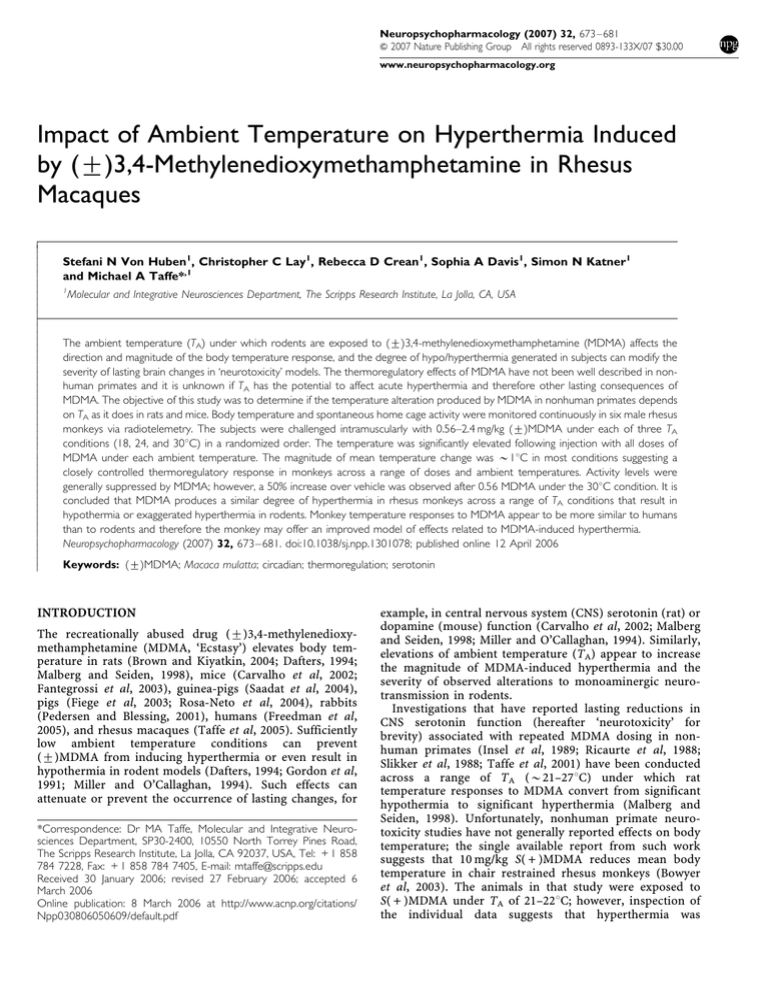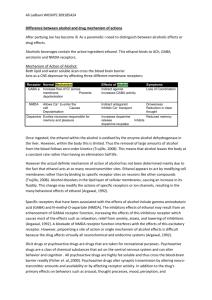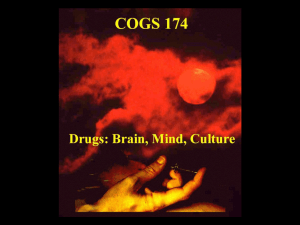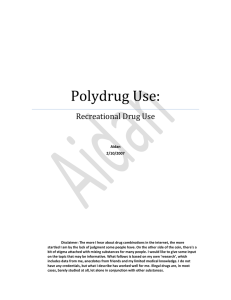
Neuropsychopharmacology (2007) 32, 673–681
& 2007 Nature Publishing Group All rights reserved 0893-133X/07 $30.00
www.neuropsychopharmacology.org
Impact of Ambient Temperature on Hyperthermia Induced
by (7)3,4-Methylenedioxymethamphetamine in Rhesus
Macaques
Stefani N Von Huben1, Christopher C Lay1, Rebecca D Crean1, Sophia A Davis1, Simon N Katner1
and Michael A Taffe*,1
1
Molecular and Integrative Neurosciences Department, The Scripps Research Institute, La Jolla, CA, USA
The ambient temperature (TA) under which rodents are exposed to (7)3,4-methylenedioxymethamphetamine (MDMA) affects the
direction and magnitude of the body temperature response, and the degree of hypo/hyperthermia generated in subjects can modify the
severity of lasting brain changes in ‘neurotoxicity’ models. The thermoregulatory effects of MDMA have not been well described in nonhuman primates and it is unknown if TA has the potential to affect acute hyperthermia and therefore other lasting consequences of
MDMA. The objective of this study was to determine if the temperature alteration produced by MDMA in nonhuman primates depends
on TA as it does in rats and mice. Body temperature and spontaneous home cage activity were monitored continuously in six male rhesus
monkeys via radiotelemetry. The subjects were challenged intramuscularly with 0.56–2.4 mg/kg (7)MDMA under each of three TA
conditions (18, 24, and 301C) in a randomized order. The temperature was significantly elevated following injection with all doses of
MDMA under each ambient temperature. The magnitude of mean temperature change was B11C in most conditions suggesting a
closely controlled thermoregulatory response in monkeys across a range of doses and ambient temperatures. Activity levels were
generally suppressed by MDMA; however, a 50% increase over vehicle was observed after 0.56 MDMA under the 301C condition. It is
concluded that MDMA produces a similar degree of hyperthermia in rhesus monkeys across a range of TA conditions that result in
hypothermia or exaggerated hyperthermia in rodents. Monkey temperature responses to MDMA appear to be more similar to humans
than to rodents and therefore the monkey may offer an improved model of effects related to MDMA-induced hyperthermia.
Neuropsychopharmacology (2007) 32, 673–681. doi:10.1038/sj.npp.1301078; published online 12 April 2006
Keywords: (7)MDMA; Macaca mulatta; circadian; thermoregulation; serotonin
INTRODUCTION
The recreationally abused drug (7)3,4-methylenedioxymethamphetamine (MDMA, ‘Ecstasy’) elevates body temperature in rats (Brown and Kiyatkin, 2004; Dafters, 1994;
Malberg and Seiden, 1998), mice (Carvalho et al, 2002;
Fantegrossi et al, 2003), guinea-pigs (Saadat et al, 2004),
pigs (Fiege et al, 2003; Rosa-Neto et al, 2004), rabbits
(Pedersen and Blessing, 2001), humans (Freedman et al,
2005), and rhesus macaques (Taffe et al, 2005). Sufficiently
low ambient temperature conditions can prevent
(7)MDMA from inducing hyperthermia or even result in
hypothermia in rodent models (Dafters, 1994; Gordon et al,
1991; Miller and O’Callaghan, 1994). Such effects can
attenuate or prevent the occurrence of lasting changes, for
*Correspondence: Dr MA Taffe, Molecular and Integrative Neurosciences Department, SP30-2400, 10550 North Torrey Pines Road,
The Scripps Research Institute, La Jolla, CA 92037, USA, Tel: + 1 858
784 7228, Fax: + 1 858 784 7405, E-mail: mtaffe@scripps.edu
Received 30 January 2006; revised 27 February 2006; accepted 6
March 2006
Online publication: 8 March 2006 at http://www.acnp.org/citations/
Npp030806050609/default.pdf
example, in central nervous system (CNS) serotonin (rat) or
dopamine (mouse) function (Carvalho et al, 2002; Malberg
and Seiden, 1998; Miller and O’Callaghan, 1994). Similarly,
elevations of ambient temperature (TA) appear to increase
the magnitude of MDMA-induced hyperthermia and the
severity of observed alterations to monoaminergic neurotransmission in rodents.
Investigations that have reported lasting reductions in
CNS serotonin function (hereafter ‘neurotoxicity’ for
brevity) associated with repeated MDMA dosing in nonhuman primates (Insel et al, 1989; Ricaurte et al, 1988;
Slikker et al, 1988; Taffe et al, 2001) have been conducted
across a range of TA (B21–271C) under which rat
temperature responses to MDMA convert from significant
hypothermia to significant hyperthermia (Malberg and
Seiden, 1998). Unfortunately, nonhuman primate neurotoxicity studies have not generally reported effects on body
temperature; the single available report from such work
suggests that 10 mg/kg S( + )MDMA reduces mean body
temperature in chair restrained rhesus monkeys (Bowyer
et al, 2003). The animals in that study were exposed to
S( + )MDMA under TA of 21–221C; however, inspection of
the individual data suggests that hyperthermia was
Ambient temperature and MDMA hyperthermia
SN Von Huben et al
674
observed in at least one of the individuals (J Bowyer and M
Paule, personal communication). Interestingly, the one
animal with a clear hyperthermic response following the
first S( + )MDMA dose later exhibited the greatest degree of
impairment on a learning task (Bowyer et al, 2003). This
suggests that body temperature changes in monkeys may
indeed be relevant for understanding the outcome of
neurotoxic and other dose regimens.
We have recently established that an intramuscular dose
of 1.7 mg/kg of (7)MDMA, or either enantiomer, administered under TA of 23–241C in unrestrained rhesus monkeys
elevates body temperature without significant increases in
locomotor activity (Taffe et al, 2005). Interestingly, Freedman et al (2005) have shown that body temperature is
elevated in human volunteers after 2.0 mg/kg (7)MDMA
per os and that this effect is similar under TA of 18 or 301C.
The present study was designed to evaluate the impact of
ambient temperature on thermoregulatory disruption produced by a recreational range of doses of (7)MDMA in
rhesus monkeys. The hypothesis to be tested was that this
larger-bodied laboratory species would be insensitive to the
effects of ambient temperature as are humans (Freedman
et al, 2005) and therefore differ qualitatively from the rat
(Malberg and Seiden, 1998).
latter four animals had previously participated in a prior
series of challenges with MDMA encompassing no more
than eight doses of racemic MDMA or either enantiomer,
administered at a dose of 1.7 mg/kg, generally intramuscularly but at least once each p.o., at 1- to 2-week intervals
(Taffe et al, 2005).
Apparatus
Radio telemetric transmitters (TA10TA-D70; Transoma
Medical/Data Sciences International; Arden Hills, MN,
USA) were implanted subcutaneously in the flank. The
surgical protocol was adapted from the manufacturer’s
surgical manual and implantation was conducted by, or
under supervision of, the TSRI veterinary staff using sterile
techniques. Temperature and gross locomotor activity
recordings were obtained continuously via an in-cage
receiver and recorded on a 5 min sample interval basis by
the controlling computer. The system requires the animal to
move across approximately half the cage width to record an
activity ‘count’. Ambient room temperature was also
recorded by the system via a thermometer mounted near
the top of the housing room.
Drug Challenge Studies
MATERIALS AND METHODS
Animals
Six male rhesus monkeys (Macaca mulatta; Chinese origin)
participated in this study. Animals were 5 years of age,
weighed 7.8–10.4 kg at the start of the study, and exhibited
body condition scores (Clingerman and Summers, 2005) of
2.0–2.5 out of 5 at the nearest quarterly exam. Daily chow
(Lab Diet 5038, PMI Nutrition International; 3.22 kcal of
metabolizable energy (ME) per gram) allocations were
determined by a power function (Taffe, 2004a, b) fit to data
provided in a National Research Council recommendation
(NRC/NAS, 2003) and modified individually by the
veterinary weight management plan. Daily chow ranged
from 215 to 254 g/day for the animals in this study. The
animals’ normal diet was supplemented with fruit or
vegetables 7 days/week and water was available ad libitum
in the home cage at all times. Animals on this study had
previously been immobilized with ketamine (5–20 mg/kg)
no less than semiannually for purposes of routine care and
some experimental procedures. Animals also had various
acute exposures to scopolamine, raclopride, methylphenidate, SCH23390, D9-THC, nicotine, and mecamylamine in
behavioral pharmacological studies. No experimental drug
treatments had been administered for a minimum of 1 year
before the start of telemetry investigations. All protocols
were approved by the Institutional Animal Care and Use
Committee of The Scripps Research Institute. The United
States National Institutes of Health guidelines for laboratory
animal care (Clark et al, 1996) were followed, save the
IACUC-approved elevation of ambient temperature outside
the Guide-recommended range for this experiment. Four
additional individuals not on the relevant protocol
remained in the room for the ambient temperature studies
by decision of the Attending Veterinarian following
consideration of all aspects of animal well-being. These
Neuropsychopharmacology
For these studies, 0.0, 0.56, 1.0, 1.78, or 2.4 mg/kg of (7)3,4methylenedioxymethamphetamine HCl (MDMA) was administered intramuscularly in a volume of 0.1 ml/kg saline.
(7)MDMA was provided by the National Institute on Drug
Abuse. Animals were injected via brief physical restraint
using the moveable back of the home cage, a procedure to
which they are well accustomed. All animals remained in
the home cage for the duration of the study. The dose range
were based on pill-content analyses suggesting B75–125 mg
MDMA per ‘Ecstasy’ pill, thus 1–1.78 mg/kg MDMA for a
single pill taken by the standard 70 kg person but as much
as 2.5 mg/kg in a 50 kg woman or as little as 0.83 mg/kg in a
90 kg man. The ambient room temperature was normally set
at 241C with a daily range of no more than 11C. For low and
high TA conditions, the room was set to 18 or 301C at 0830
and restored to 241C at 1630. The room probe confirmed
that TA conditions were met within a variance of B11C. All
challenges were administered at 1030 with active doses
separated by at least 1 week in a pseudorandomized order.
Data Analysis
The temperature and activity data were collected each 5 min
and analysis time points were thereafter expressed as a
moving average of three samples (5 min, current, + 5 min)
for each 10 min time point. Two-way randomized block
analysis of variance (ANOVA) was employed to evaluate
acute treatment-related effects starting 10 min before
injection (as the preinjection comparison) and continuing
until 240 min postinjection (p.i.). This interval was selected
for analysis because animals were fed chow and supplements after this interval, as under normal conditions. Thus,
the two within-subjects factors for ANOVA were time
relative to injection (10 to 240) and ambient temperature
condition (18, 24, and 301C); separate analyses were
conducted for each drug dose. Telemetry data from the
Ambient temperature and MDMA hyperthermia
SN Von Huben et al
675
four additional animals in the housing room were being
collected under a different protocol and were used here for
additional comparisons. As these animals did not undergo
differential treatment on the days of changed ambient
temperature, observations were collapsed across four
observations under a given ambient condition for each of
these individuals. Significant main effects in the two-way
ANOVAs were followed up with the Newman–Keuls post
hoc procedure to evaluate all pairwise comparisons. Average
temperature and summed activity counts for the interval 2 h
p.i. were analyzed by one-way repeated measures ANOVA
for each ambient temperature with a factor of drug
treatment condition. Any significant main effects were
followed with the Newman–Keuls post hoc procedure to
evaluate all pairwise comparisons and the Dunnett post hoc
test to determine differences from the vehicle condition. All
statistical analyses were conducted using GB-STAT v7.0 for
Windows (Dynamic Microsystems Inc., Silver Spring, MD,
USA) and the criterion for significance in all tests was
po0.05.
RESULTS
The administration of (7)MDMA resulted in an increase of
subcutaneous body temperature under all treatment conditions (Figure 1). The effect was observed within 5–10 min
after injection (the elevation of the ‘0’ time point reflects
inevitable variability in the timing of injecting six animals
relative to the computer sampling schedule as well as the
moving average analysis) and animals reached a temperature peak about 20–40 min p.i. Body temperature was
relatively stable in the 90 min before injection in each of the
altered TA conditions with the warmest condition resulting
in an average increase of about 0.51C relative to the
standard TA condition. Effects of the low ambient temperature observed in the interval before injection differed from
the standard condition less consistently.
Statistical analysis was conducted for each drug dose to
confirm the impact of (7)MDMA exposure at each of the
ambient temperature conditions for the interval 10 min
through 240 min p.i. For the 0.56 mg/kg dose, the analysis
confirmed a main effect of TA condition (F2,10 ¼ 18.16;
po0.001), of time p.i. (F25,125 ¼ 19.86; po0.0001), and an
interaction of factors (F50,250 ¼ 5.83; po0.0001). The post
hoc analysis further confirmed that temperature was
significantly elevated relative to the preinjection baseline
under 181C (10–30 min p.i.), 241C (10–100 min p.i.), and
301C (10–70 min p.i.) conditions. Furthermore, temperature
was significantly lower in the 181C TA condition 40–210 min
p.i. in comparison with the same time points in the 241C TA
condition and lower for time points 20–240 min p.i. in the
301C TA condition. Temperature in the 301C TA condition
was reliably higher before injection and 10–20 min p.i. in
comparison with the 241C TA condition at any time point
analyzed.
Figure 1 The mean (N ¼ 6, bars indicate SEM) subcutaneous temperature values following acute challenge with four doses of (7)MDMA under each of
three ambient temperature conditions. The break in the series indicates the time of injection; the slight change at time ‘0’ reflects variation in injecting all six
subjects relative to the computer sampling schedule and the moving average procedure; see Materials and methods. A significant difference from the time
point preceding injection is indicated by the open symbols; additional significant differences are detailed in Results.
Neuropsychopharmacology
Ambient temperature and MDMA hyperthermia
SN Von Huben et al
676
For the 1.0 mg/kg dose, the analysis confirmed a main
effect of TA condition (F2,10 ¼ 40.54; po0.0001), of time p.i.
(F25,125 ¼ 46.56; po0.0001), and an interaction of factors
(F50,250 ¼ 2.26; po0.0001). Post hoc analysis confirmed that
temperature was significantly elevated relative to the
preinjection baseline under 181C (10–60 min p.i.), 241C
(10–70 min p.i.), and 301C (10–60 min p.i.) conditions, and
that temperature was significantly lower in the 181C TA
condition before injection and 70–240 min p.i. in comparison with the same time points in the 241C TA condition and
lower for all time points except 30–60 min p.i. in the 301C
TA condition. Temperature in the 241C TA condition did not
reliably differ from the 301C TA condition at any time point
analyzed.
For the 1.78 mg/kg dose, the analysis confirmed a main
effect of TA condition (F2,10 ¼ 20.95; po0.001), of time p.i.
(F25,125 ¼ 11.48; po0.0001), and an interaction of factors
(F50,250 ¼ 1.43; po0.05). The post hoc test confirmed that
temperature was significantly elevated relative to the
preinjection baseline under 181C (10–60 min p.i.), 241C
(10–60 min p.i.), and 301C (10–70 min p.i.) conditions.
Temperature was significantly lower in the 181C TA
condition 110–240 min p.i. in comparison with the same
time points in the 241C TA condition and lower for time
points 20–50 and 80–240 min p.i. in the 301C TA condition.
Temperature in the 241C TA condition did not reliably differ
from the 301C TA condition at any time point analyzed.
For the 2.4 mg/kg dose, the analysis confirmed a main
effect of TA condition (F2,10 ¼ 13.23; po0.01), of time p.i.
(F25,125 ¼ 12.78; po0.0001), and an interaction of factors
(F50,250 ¼ 1.46; po0.05). Temperature was significantly
elevated relative to the preinjection baseline under 181C
(10–100 min p.i.), 241C (10–80 min p.i.), and 301C (10–
60 min p.i.) conditions as confirmed with the post hoc
analysis. Temperature was significantly lower in the 181C TA
condition for all time points except 10–150 min p.i. in
comparison with the same time points in the 241C TA
condition and lower for all time points in comparison in the
301C TA condition. Temperature in the 241C TA condition
did not reliably differ from the 301C TA condition at any
time point analyzed.
Intersubject heterogeneity was observed as illustrated
in Figure 2 for the highest and lowest dose. Individual
hyperthermic responses ranged from about 0.4–0.51C
over preinjection baseline to as much as 1.8–2.01C
over preinjection baseline. It is also apparent that individual
animals exhibit a reasonable amount of consistency
across (7)MDMA dose and ambient temperature in terms
of both the magnitude and duration of the temperature
response.
Figure 2 The individual subjects’ subcutaneous temperatures following acute challenge with the lowest and highest doses of (7)3,4-MDMA are depicted
for each of three ambient temperatures. The data are represented as changes from the individuals’ baseline temperature in degrees Celsius.
Neuropsychopharmacology
Ambient temperature and MDMA hyperthermia
SN Von Huben et al
677
Figure 3 The mean (N ¼ 6, + SEM) average body temperature (upper
panel) and summed activity counts (lower panel) across the 2-h interval
following injection of MDMA or vehicle under each of three ambient
temperature conditions. A significant difference from vehicle is indicated by
* and a significant difference from the 0.56 mg/kg dose is indicated by }.
Figure 4 The mean subcutaneous temperature values following vehicle
injection under three ambient temperature conditions for the experimental
group (N ¼ 6, bars indicate SEM) are presented in the top panel. A
significant difference from the time point preceding injection is indicated by
the open symbols. The lower panel presents mean (N ¼ 4, bars indicate
SEM) subcutaneous temperature under each ambient temperature for an
untreated control group. The control group’s data reflect grand averages of
individual data averaged across four sessions for each ambient condition.
These data are represented relative to the time of injection of the
treatment group within the same housing room.
Average temperature in the interval 2-h after injection
(Figure 3) was confirmed by significant main effects of drug
treatment condition under the 181C TA (F4,36 ¼ 12.53;
po0.0001), the 241C TA (F4,36 ¼ 3.23; po0.05), and the
301C TA (F4,36 ¼ 5.42; po0.01) conditions. Post hoc comparisons confirmed significant increases over vehicle for the
1.0–2.4 mg/kg doses at 181C TA and for the 2.4 mg/kg dose
at either 241C TA or 301C TA. Activity patterns were highly
consistent with our prior report (Taffe et al, 2005) with
activity levels being highest at the time of injection and
thereafter decreasing to low levels for up to 3 h after
injection. These patterns were nearly identical across all
treatment conditions, including vehicle. The summed
activity counts did differ between conditions in the interval
2 h after injection (Figure 3) as confirmed by significant
main effects of drug treatment condition under the 181C TA
(F4,36 ¼ 5.24; po0.01), the 241C TA (F4,36 ¼ 3.74; po0.05),
and the 301C TA (F4,36 ¼ 13.53; po0.0001) conditions. The
post hoc tests confirmed that activity levels were significantly lower than vehicle or 0.56 mg/kg MDMA following
2.4 mg/kg MDMA under the 181C condition, and lower than
vehicle for all MDMA doses under the 241C TA condition.
Activity was significantly higher than vehicle and the
three remaining MDMA doses after 0.56 mg/kg MDMA in
the 301C TA condition. Thus, locomotor activity most
frequently decreased following MDMA administration;
however, a slight increase in activity relative to vehicle
was observed after the lowest dose of MDMA in the high
ambient temperature condition.
Analysis of the vehicle data for the treated animals
(Figure 4) confirmed a main effect of TA condition
(F2,10 ¼ 19.43; po0.001), of time p.i. (F25,125 ¼ 7.17;
po0.0001), and an interaction of factors (F50,250 ¼ 1.41;
po0.05). The post hoc tests confirmed that temperature was
significantly elevated relative to the preinjection baseline
under 241C (20–30 min p.i.) and 301C (10–30 min p.i.)
conditions and significantly lower than preinjection in
the 181C condition at one time point (130 min) after
injection. Analysis of the temperature data from the four
uninjected control animals (Figure 4) confirmed a main
effect of TA condition (F2,6 ¼ 76.85; po0.0001), of time p.i.
(F25,75 ¼ 10.55; po0.0001), and an interaction of factors
(F50,150 ¼ 229; po0.0001). Temperature in these animals was
significantly elevated relative to the preinjection baseline
under 181C (10–40 min p.i.), 241C (20–30 min p.i.), and 301C
(10–70 min p.i.) conditions as confirmed with the post hoc
analysis.
Additional analysis was conducted on the activity data to
compare the effect of vehicle or 2.4 mg/kg MDMA under the
three ambient conditions for the interval 30 min before
Neuropsychopharmacology
Ambient temperature and MDMA hyperthermia
SN Von Huben et al
678
Figure 5 The mean (N ¼ 6, + SEM) activity levels in the vehicle and 2.4 mg/kg MDMA conditions are presented for the experimental group under each of
three ambient temperatures. The activity data for the control group are also presented; details are as described in the Figure 4 legend. Significant differences
from the time of injection are indicated by *.
injection until 90 min after injection (Figure 5). A three-way
repeated measures ANOVA confirmed a significant main
effect of time p.i. (F12,60 ¼ 25.22; po0.0001) and an
interaction of time p.i. with drug condition (F12,60 ¼ 3.90;
po0.001). There were statistically unreliable trends for a
main effect of drug condition (p ¼ 0.080) and the interaction
of ambient temperature with time p.i. (p ¼ 0.059). In the
181C condition, activity was significantly lower 10–80 min
after MDMA and 20–90 min after vehicle, when compared
with activity at the time of injection. Similar activity
reductions relative to the time of injection were observed
20–90 min after MDMA and 30–40 min after vehicle in the
241C ambient condition. Finally, activity was significantly
lower 20–90 min after injection of either vehicle or MDMA
in the 301C ambient condition.
DISCUSSION
The results of this study show that (7)MDMA causes an
acute elevation of body temperature in rhesus macaques
across an ambient temperature range of 18–301C. Thus, the
monkey appears to respond similarly to humans (Freedman
et al, 2005) and differently from rats, which become
hypothermic after MDMA at 201C ambient temperature
(Malberg and Seiden, 1998). The overall implication of this
work is that while smaller bodied mammals may be
protected from MDMA-induced temperature elevations
below B201C, this is unlikely to be the case for macaque
monkeys or humans. These data also extend our initial
study (Taffe et al, 2005) by demonstrating that the monkeys
develop approximately equivalent changes in body temperature following a recreationally relevant range of MDMA
doses (0.56–2.4 mg/kg). Reassuringly, the data suggest that
comparisons made between the results of prior monkey
Neuropsychopharmacology
neurotoxicity studies are unlikely to be substantially
affected by the wide range of ‘normal’ ambient temperatures
(B21–271C) under which they have been conducted.
One important finding in this study is the identification of
within-individual consistency and between-individual
variability in the magnitude and duration of the temperature response. Such natural variation in phenotype may
provide important clues to individual sensitivity. In human
Ecstasy users, for example, threatening hyperthermia
requiring emergency medical intervention apparently only
occurs in a very small fraction of users. We have recently
observed a situation in which emergency medical intervention was required to recover a monkey after an acute
intramuscular dose of 2.4 mg/kg S( + )MDMA, which
resulted in seizure and hyperthermia. This was unexpected
because the animal had received acute doses of 2.4 mg/kg
racemic and R()MDMA as well as of 1.7 mg/kg racemic
and both enantiomers of MDMA previously and no drug
challenges had been administered for 3 months before this
event (however, see Giorgi et al, 2005). The LD50 in rhesus
monkeys has been estimated as 22 mg/kg (7)MDMA, i.v.
(Hardman et al, 1973) and limited data suggest that a
cumulative (over 6 h) dose of 25.8 mg/kg (7)MDMA, p.o.
was lethal in at least 33% of squirrel monkeys whereas a
cumulative dose of 19.2 mg/kg was not (Mechan et al, 2006).
As emergency medical events are not obviously related to
dose in humans, nor in monkeys, some as yet unknown
individual factors must be of primary significance. Individual differences in the monkey temperature response to
MDMA may therefore provide important clues to the
etiology of medical emergencies in human Ecstasy users.
These findings also have important practical implications for experimental design in typically low ‘N’ monkey
studies. For example, Yuan et al (2006) found that a
threatening hyperthermia is more likely to be evoked by
Ambient temperature and MDMA hyperthermia
SN Von Huben et al
679
methamphetamine under 331C than 261C ambient conditions. The study, however, employed a between-subjects
design and the difference appeared to be attributable to
aberrant responses from 2/4 animals treated at 331C. The
present data (Figure 2) suggest that it would be quite
possible to accidentally assign animals of significantly
different temperature phenotype to different treatment
groups given pools of 6–8 subjects.
One interesting feature of the present data was the unique
result of the lowest dose of MDMA administered at 181C.
Although an acute elevation of temperature was observed
until 30–40 min p.i., this was the only case in which temperature dropped significantly (and consistently; Figure 2)
below baseline within a few hours of dosing. This pattern is
similar to that reported for rat following 40 mg/kg
(7)MDMA at 201C TA (Malberg and Seiden, 1998). Thus
it is possible that consistent MDMA-induced hypothermia
may occur in humans and non-human primates albeit under
even lower ambient temperatures and/or with lower doses.
The activity data extend our prior report (Taffe et al,
2005) in confirming that (7)MDMA tends to suppress
activity levels in monkeys. This is fortuitous as an
interpretive matter because the temperature response can
be observed independent of skeletal muscle activity/heat
generation. Therefore, the present model most likely reflects
heat generation from stimulation of metabolic rate (Freedman et al, 2005) as opposed to skeletal muscle activation. In
contrast, rodent models appear to indicate that locomotor
increases are usually observed in concert with temperature
increases although it should be appreciated that rodent
studies have often been conducted without examination
of diurnal cycle; thus, close comparisons of effects in lightvs dark-cycle MDMA administration may be necessary
to clearly establish Order differences. Interestingly, the
temperature responses in the vehicle condition for the
experimental group, as well as for the control group,
emphasize that even relatively small differences in activity
profile, sustained over tens of minutes, can result in acute
elevations of body temperature, which render interpretations of drug effects complex at best. This is apparent with
even a casual inspection of telemetry data in treatment
naı̈ve animals, which is why we first designed the period of
observation following drug challenge to be as devoid of
room ‘excitement’ as possible (Taffe et al, 2005). Of even
further interest was the observation that although the effect
of MDMA on temperature did not appear to interact with
TA, the effect of increased activity (Figure 5) on body
temperature (Figure 4) did appear to interact with TA.
Temperature effects of activity were smaller at low ambient
conditions, whereas effects of active drug were not.
The present results also provide evidence regarding the
response of thermoregulatory mechanisms to MDMA in the
monkey. Subcutaneous body temperature data are not
identical to ‘core’ body temperature but are likely closely
correlated in the macaque. For this study, mean temperature before challenge was about 11C lower than values
reported for intraperitoneal temperature in Japanese
(Takasu et al, 2002) and pigtail (MR Weed, personal
communication) macaques; this was consistent with prior
reports for subcutaneous temperature in cynomolgous
(Almirall et al, 2001) and rhesus (Horn et al, 1998)
macaques. The circadian patterns of temperature regulation
appear highly similar between s.c. and i.p. studies in terms
of the magnitude of temperature variation from day to night
as well as the magnitude of individual temperature variation
across intervals as short as 5–10 min. In our recent studies,
we have compared rectal temperatures (obtained under
light ketamine anesthesia) with concurrent telemetric
temperature values in 17 monkeys; multiple determinations
are available for most animals. The s.c. values were B1–31C
lower than (immobilized) rectal temperature across animals
but the temperature differential is consistent across
determinations within animal. For comparison, the skin
temperature of macaques is about 71C lower than rectal
temperature at TA of 181C and about 2.51C lower than rectal
temperature at TA of 301C (Johnson and Elizondo, 1979).
Human skin temperature is about 41C lower than core
temperature at 181C and about 1.51C lower than core
temperature at 301C (Freedman et al, 2005). In contrast, the
core temperature of humans, rhesus monkeys, and rats does
not vary substantially across 18–301C TA conditions
(Freedman et al, 2005; Johnson and Elizondo, 1979; Malberg
and Seiden, 1998). A mean effect of only B0.51C,
attributable to TA, was observed in the present study
suggesting that s.c. temperature is only minimally influenced by ambient conditions.
The question of temperature probe location is potentially
important because MDMA produces peripheral vasoconstriction. This effect can produce stable or lowered skin
temperature at the same time as increased core temperature
in rats and rabbits (Mechan et al, 2002; Pedersen and
Blessing, 2001), which suggests that impairment of peripheral heat shedding is an important contributor to
MDMA-associated hyperthermia (Mills et al, 2004), at least
in small mammals. The vehicle data from the present study
demonstrate that peripheral shedding of heat induced by
muscular activity is indeed significantly affected across the
24 or 301C TA range in monkeys. Such considerations
predict that the effect of MDMA on subcutaneous
temperature might potentially be biased upward under
high, and downward under low, TA conditions in comparison with ‘core’ temperature. In contrast to this prediction,
the observed change in temperature over preinjection
baseline in the present study was similar under all
conditions in the monkeys. The mean peak change in
temperature ranged from 0.9 to 1.11C for all MDMA doses
in the 24 or 301C TA conditions. The mean changes in the
low ambient condition were slightly more variable but
ranged from 0.651C (0.56 mg/kg) to 1.31C (2.4 mg/kg),
suggesting no consistent interaction with the ambient
temperature. Interestingly, Freedman et al (2005) showed
that despite an B21C difference in skin temperature across
18–301C TA conditions in humans, (7)MDMA induced
changes in the temperature of skin and core of approximately the same magnitude. Human peripheral thermoregulation by vasodilation/vasoconstriction and sweating
appears to be independently mediated (Inoue et al, 1998;
Schick et al, 2003). Freedman and colleagues found that
sweating onset in humans is at a core temperature of 35.51C
and a skin temperature of 371C. In rhesus monkeys,
sweating starts at a rectal temperature of 37.71C and a skin
temperature of 35.41C (Johnson and Elizondo, 1974)
but this threshold is markedly increased by (7)MDMA
(Freedman et al, 2005); the skin temperature appeared to
Neuropsychopharmacology
Ambient temperature and MDMA hyperthermia
SN Von Huben et al
680
stabilize immediately after the onset of sweating. In
combination with the nearly identical magnitude of the
MDMA effect on skin vs core temperature, this suggests that
cutaneous vascular changes may contribute little to thermoregulation under these conditions. The most important
conclusion is that primates likely exhibit a more consistent
and linear relationship between core, subcutaneous, and skin
temperature following MDMA in comparison with rodents. A
second conclusion is that it is critical for the comparison of
preclinical models to consider the role of locomotor activity.
Additional study of rodent models in which MDMA does not
consistently elevate activity and monkey models where it
does would be of significant interest.
In summary, this study determined that (7)MDMA
produces acute hyperthermia in non-human primates in
ambient temperature conditions ranging from 18 to 301C. In
this the monkey appears to be more similar to humans and
less similar to rodents. The change in monkeys’ temperature
over baseline was of an equivalent magnitude from high to
low ambient temperature conditions across a range of doses
that are similar to human recreational, and proposed
clinical, doses. Therefore, low ambient temperatures that
are neuroprotective in rodents are unlikely to have similar
effects in monkeys or humans. The present findings thus
have important implications for the translation of animal
studies to human situation including both the recreational
and clinical use of MDMA.
ACKNOWLEDGEMENTS
This work was supported by USPHS Grant DA018418. This
is publication #17979-MIND from The Scripps Research
Institute.
REFERENCES
Almirall H, Bautista V, Sanchez-Bahillo A, Trinidad-Herrero M
(2001). Ultradian and circadian body temperature and activity
rhythms in chronic MPTP treated monkeys. Neurophysiol Clin
31: 161–170.
Bowyer JF, Young JF, Slikker W, Itzak Y, Mayorga AJ, Newport GD
et al (2003). Plasma levels of parent compound and metabolites
after doses of either d-fenfluramine or d-3,4-methylenedioxymethamphetamine (MDMA) that produce long-term serotonergic alterations. Neurotoxicology 24: 379–390.
Brown PL, Kiyatkin EA (2004). Brain hyperthermia induced by
MDMA (ecstasy): modulation by environmental conditions. Eur
J Neurosci 20: 51–58.
Carvalho M, Carvalho F, Remiao F, de Lourdes Pereira M,
Pires-das-Neves R, de Lourdes Bastos M (2002). Effect of
3,4-methylenedioxymethamphetamine (‘ecstasy’) on body temperature and liver antioxidant status in mice: influence of
ambient temperature. Arch Toxicol 76: 166–172.
Clark JD, Baldwin RL, Bayne KA, Brown MJ, Gebhart GF, Gonder
JC et al (1996). Guide for the Care and Use of Laboratory
Animals. Institute of Laboratory Animal Resources, National
Research Council: Washington, DC. pp 125.
Clingerman KJ, Summers L (2005). Development of a body
condition scoring system for nonhuman primates using Macaca
mulatta as a model. Lab Anim (NY) 34: 31–36.
Dafters RI (1994). Effect of ambient temperature on hyperthermia
and hyperkinesis induced by 3,4-methylenedioxymethamphetNeuropsychopharmacology
amine (MDMA or ‘ecstasy’) in rats. Psychopharmacology (Berl)
114: 505–508.
Fantegrossi WE, Godlewski T, Karabenick RL, Stephens JM, Ullrich
T, Rice KC et al (2003). Pharmacological characterization of the
effects of 3,4-methylenedioxymethamphetamine (‘ecstasy’) and
its enantiomers on lethality, core temperature, and locomotor
activity in singly housed and crowded mice. Psychopharmacology (Berl) 166: 202–211.
Fiege M, Wappler F, Weisshorn R, Gerbershagen MU, Menge M,
Schulte Am Esch J (2003). Induction of malignant hyperthermia
in susceptible swine by 3,4-methylenedioxymethamphetamine
(‘ecstasy’). Anesthesiology 99: 1132–1136.
Freedman RR, Johanson CE, Tancer ME (2005). Thermoregulatory
effects of 3,4-methylenedioxymethamphetamine (MDMA) in
humans. Psychopharmacology (Berl) 183: 248–256.
Giorgi FS, Pizzanelli C, Ferrucci M, Lazzeri G, Faetti M, Giusiani M
et al (2005). Previous exposure to (+/) 3,4-methylenedioxymethamphetamine produces long-lasting alteration in limbic
brain excitability measured by electroencephalogram spectrum
analysis, brain metabolism and seizure susceptibility. Neuroscience 136: 43–53.
Gordon CJ, Watkinson WP, O’Callaghan JP, Miller DB (1991).
Effects of 3,4-methylenedioxymethamphetamine on autonomic
thermoregulatory responses of the rat. Pharmacol Biochem
Behav 38: 339–344.
Hardman HF, Haavik CO, Seevers MH (1973). Relationship of the
structure of mescaline and seven analogs to toxicity and
behavior in five species of laboratory animals. Toxicol Appl
Pharmacol 25: 299–309.
Horn TF, Huitron-Resendiz S, Weed MR, Henriksen SJ, Fox HS
(1998). Early physiological abnormalities after simian immunodeficiency virus infection. Proc Natl Acad Sci USA 95: 15072–
15077.
Inoue Y, Shibasaki M, Hirata K, Araki T (1998). Relationship between skin blood flow and sweating rate, and age
related regional differences. Eur J Appl Physiol Occup Physiol 79:
17–23.
Insel TR, Battaglia G, Johannessen JN, Marra S, De Souza EB
(1989). 3,4-Methylenedioxymethamphetamine (‘ecstasy’) selectively destroys brain serotonin terminals in rhesus monkeys.
J Pharmacol Exp Ther 249: 713–720.
Johnson GS, Elizondo RS (1974). Eccrine sweat gland in Macaca
mulatta: physiology, histochemistry, and distribution. J Appl
Physiol 37: 814–820.
Johnson GS, Elizondo RS (1979). Thermoregulation in Macaca
mulatta: a thermal balance study. J Appl Physiol 46: 268–277.
Malberg JE, Seiden LS (1998). Small changes in ambient
temperature cause large changes in 3,4-methylenedioxymethamphetamine (MDMA)-induced serotonin neurotoxicity and
core body temperature in the rat. J Neurosci 18: 5086–5094.
Mechan A, Yuan J, Hatzidimitriou G, Irvine RJ, McCann UD,
Ricaurte GA (2006). Pharmacokinetic profile of single and
repeated oral doses of MDMA in squirrel monkeys: relationship
to lasting effects on brain serotonin neurons. Neuropsychopharmacology 31: 339–350.
Mechan AO, Esteban B, O’Shea E, Elliott JM, Colado MI, Green
AR (2002). The pharmacology of the acute hyperthermic
response that follows administration of 3,4-methylenedioxymethamphetamine (MDMA, ‘ecstasy’) to rats. Br J Pharmacol
135: 170–180.
Miller DB, O’Callaghan JP (1994). Environment-, drug- and stressinduced alterations in body temperature affect the neurotoxicity
of substituted amphetamines in the C57BL/6J mouse. J
Pharmacol Exp Ther 270: 752–760.
Mills EM, Rusyniak DE, Sprague JE (2004). The role of the
sympathetic nervous system and uncoupling proteins in the
thermogenesis induced by 3,4-methylenedioxymethamphetamine. J Mol Med 82: 787–799.
Ambient temperature and MDMA hyperthermia
SN Von Huben et al
681
NRC/NAS (2003). Nutrient Requirements of Nonhuman Primates:
Second Revised Edition. National Research Council of The
National Academy of Sciences: Washington, DC.
Pedersen NP, Blessing WW (2001). Cutaneous vasoconstriction
contributes to hyperthermia induced by 3,4-methylenedioxymethamphetamine (ecstasy) in conscious rabbits. J Neurosci 21:
8648–8654.
Ricaurte GA, Forno LS, Wilson MA, DeLanney LE, Irwin I,
Molliver ME et al (1988). 3,4-Methylenedioxymethamphetamine
selectively damages central serotonergic neurons in nonhuman
primates. JAMA 260: 51–55.
Rosa-Neto P, Olsen AK, Gjedde A, Watanabe H, Cumming P
(2004). MDMA-evoked changes in cerebral blood flow in living
porcine brain: correlation with hyperthermia. Synapse 53:
214–221.
Saadat KS, Elliott JM, Colado MI, Green AR (2004). Hyperthermic
and neurotoxic effect of 3,4-methylenedioxymethamphetamine
(MDMA) in guinea pigs. Psychopharmacology (Berl) 173: 452–453.
Schick CH, Fronek K, Held A, Birklein F, Hohenberger W, Schmelz
M (2003). Differential effects of surgical sympathetic block
on sudomotor and vasoconstrictor function. Neurology 60:
1770–1776.
Slikker Jr W, Ali SF, Scallet AC, Frith CH, Newport GD, Bailey JR
(1988). Neurochemical and neurohistological alterations in the
rat and monkey produced by orally administered methylenedioxymethamphetamine (MDMA). Toxicol Appl Pharmacol 94:
448–457.
Taffe MA (2004a). Effects of parametric feeding manipulations on
behavioral performance in macaques. Physiol Behav 81: 59–70.
Taffe MA (2004b). Erratum: ‘Effects of parametric feeding
manipulations on behavioral performance in macaques’. Physiol
Behav 82: 589.
Taffe MA, Lay CC, Von Huben SN, Davis SA, Crean RD, Katner SN
(2005). Hyperthermia induced by 3,4-methylenedioxymethamphetamine in unrestrained rhesus monkeys. Drug Alcohol
Depend, 10 November [E-pub ahead of print].
Taffe MA, Weed MR, Davis S, Huitron-Resendiz S, Schroeder R,
Parsons LH et al (2001). Functional consequences of repeated
(+/)3,4-methylenedioxymethamphetamine (MDMA) treatment
in rhesus monkeys. Neuropsychopharmacology 24: 230–239.
Takasu N, Nigi H, Tokura H (2002). Effects of diurnal bright/dim
light intensity on circadian core temperature and activity
rhythms in the Japanese macaque. Jpn J Physiol 52: 573–578.
Yuan J, Hatzidimitriou G, Suthar P, Mueller M, McCann U,
Ricaurte G (2006). Relationship between temperature, dopaminergic neurotoxicity, and plasma drug concentrations in
methamphetamine-treated squirrel monkeys. J Pharmacol Exp
Ther 316: 1210–1218.
Neuropsychopharmacology








